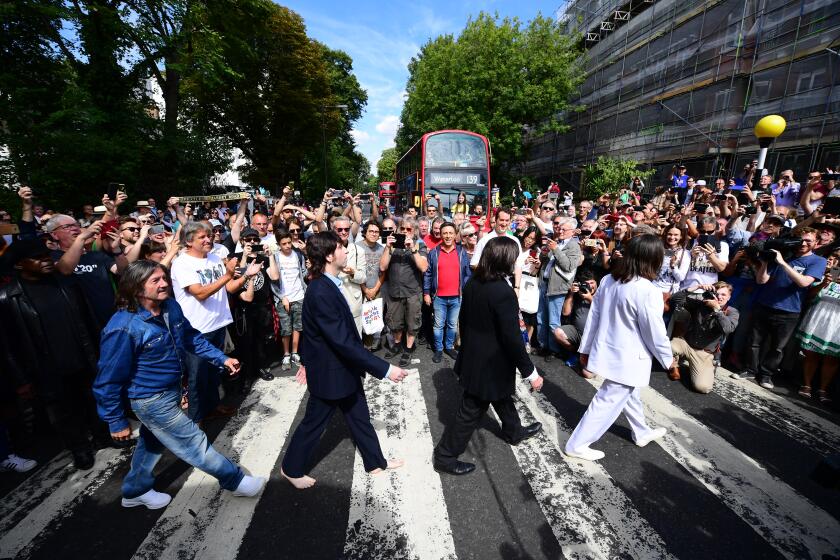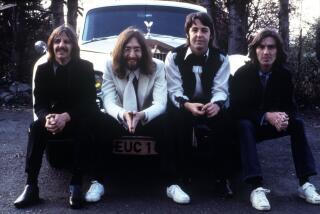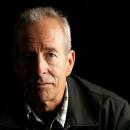A new ending: Behind the Beatles’ ‘Abbey Road’ 50th-anniversary remix
- Share via
One evening in 1969, as the Beatles were working on a scorching new John Lennon rocker called “I Want You (She’s So Heavy)” for their next album, an engineer popped his head into their London recording studio to deliver a warning.
“One of the guys says, ‘There’ve been some complaints from outside and we need to turn down a bit,’ ” latter-day Beatles producer Giles Martin said, recounting a favorite moment from the original session tapes he’s immersed himself in while assembling the 50th-anniversary remix of “Abbey Road.”
“The guitars were pretty loud and there probably was some [sound] leakage. It’s very late at night, and you hear John say, ‘Is it OK if we do one more and then we’ll turn down?’ ” Martin, 49, said between bites of a club sandwich on a recent visit to Capitol Studio B in Hollywood, unable to suppress a smile at the thought of anyone ordering the world’s biggest rock band to pipe down. As Lennon tells his mates on the session tape, “Last chance to be loud!”
Martin’s new remix of “Abbey Road” is set for release on Sept. 27, a day after the actual 50th anniversary of the album’s U.K. release, and four days ahead of the date it showed up stateside. It’s the latest in a series of sonic upgrades and musicological explorations of the Fab Four’s work, which began in earnest with the 2017 royal treatment afforded “Sgt. Pepper’s Lonely Hearts Club Band.”
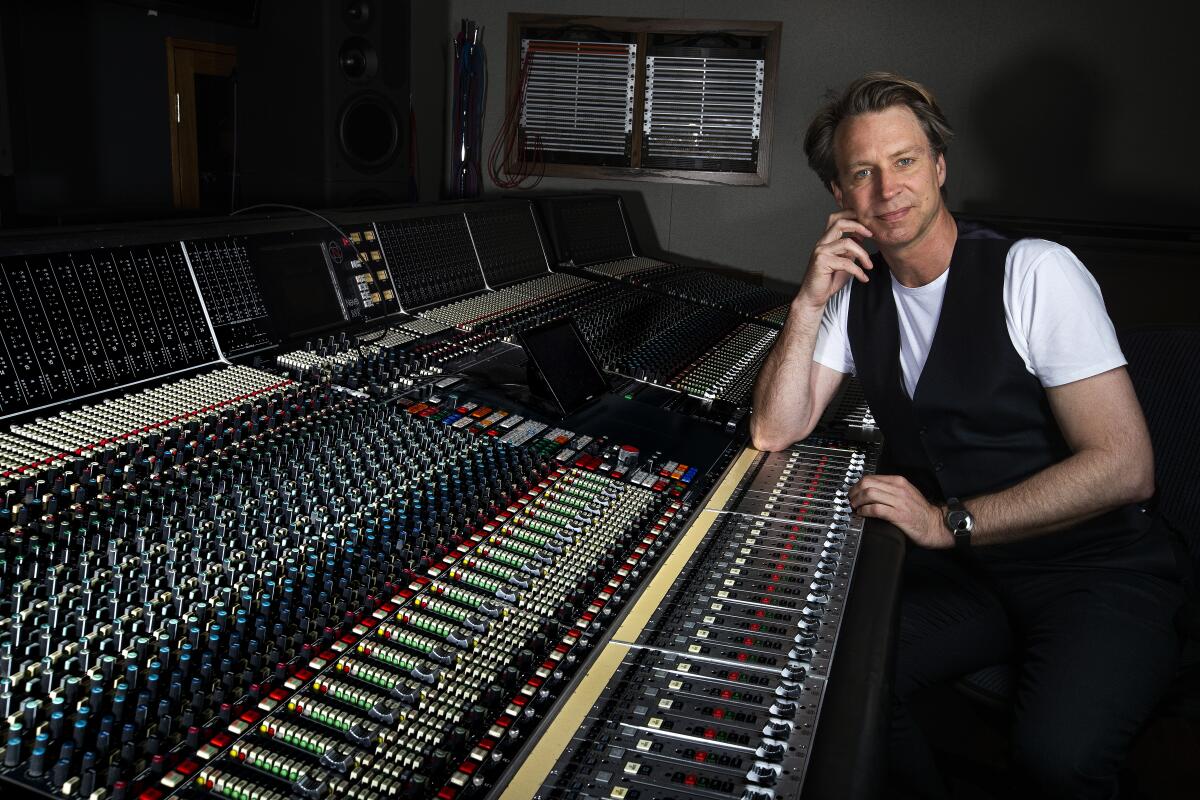
That paved the way for last year’s even more expansive 50th-anniversary reissue of their 1968 double album, “The Beatles,” a.k.a. the White Album.
As with the two previous projects, Martin has gone back to the original multi-track analog master tapes, keeping contemporary ears and audio equipment in mind for this remix of the final album recorded by Lennon, Paul McCartney, George Harrison and Ringo Starr before they formally called it quits in 1970.
“I’ve said this before: You don’t want your kids to listen to the Beatles’ records and go, ‘God, this sounds old,’ ” said Martin, who took over production of Beatles releases from his father, the group’s original producer, George Martin, who died in 2016. That passing of the torch began with their father-son collaboration that created the mashup soundtrack for “The Beatles Love” show that Cirque du Soleil has been staging in Las Vegas since 2006.
McCartney and Starr, whose bass and drum parts are generally the biggest beneficiaries of the remixes, have been enthusiastic about the updates. (Each Beatles reissue is also subject to the approval of Lennon’s widow, Yoko Ono, and Harrison’s widow, Olivia Harrison, before they are released.)
“For me, as the drummer, [the remix] is great because the drums — now you can hear them,” Starr, 79, told The Times during a recent interview at Capitol Studio A in Hollywood. He noted how in the early days of the band’s recording career, much of the bass content — most noticeably affecting the drums and bass guitar — was toned down to accommodate the record players in common usage at that time.
LONDON (AP) — It was 50 years ago today, that The Beatles caused a traffic delay.And hundreds of fans of the Fab Four gathered Thursday at a crosswalk in London’s St.
“In those days, if you wanted to take any of the bass off, you start with the bass drum stuff,” Starr said. “If you listen to something like ‘Love Me Do,’ there’s no bass drum, no bass, because we’ve taken that off.”
The 50th-anniversary “Abbey Road” reissue will be packaged in several editions, the most ambitious being a box set comprised of three CDs of audio tracks, plus a fourth Blu-ray disc with high-resolution versions of the album’s new stereo mix, a 5.1 surround-sound version and another in Dolby Atmos audiophile audio, the first for a Beatles release. It will come with a 100-page book packed with session photos, introductions from McCartney and Giles Martin, a facsimile of one of George Martin’s orchestral scores and new essays by Beatles historian Kevin Howlett and music journalist David Hepworth.

“Everything we do is done with two things in mind,” said Bruce Resnikoff, president and CEO of Universal Music Enterprises, which manages the Beatles’ recordings in partnership with the group’s Apple Corps Ltd. “One, we want to create something specifically for fans who’ve been there for as much as 50-plus years; we also want to create something engaging for young people who weren’t around when the Beatles were first going.”
The bonus audio discs with the “Abbey Road” reissue contain nearly two dozen alternate takes; studio chatter among the Beatles and other session participants; and demo versions of songs the foursome was working on at the time but were not part of the “Abbey Road” album.
Among them: both sides of their ’69 hit single “The Ballad of John and Yoko” and “Old Brown Shoe”; McCartney’s demo versions of two songs he handed off to other musicians he produced for their fledgling Apple Records label — Mary Hopkin’s “Goodbye” and Badfinger’s “Come and Get It”; plus an isolated track highlighting longtime Beatles producer-arranger George Martin’s orchestral accompaniment for Harrison’s ballad “Something.”
As to Lennon’s surprisingly polite response to the mid-session request that he and the band back off, Giles Martin thinks it’s a great example of one essential quality that suffuses “Abbey Road”: that of a conscious victory lap for a group that had scaled virtually every peak the world had to offer.
“It’s really sweet that you hear John say that,” he said. “I think that everyone’s on their best behavior to a certain extent.
“They know this is going to be their last album. You can tell they’re going to make sure it’s a good one, and that everyone’s songs are going to get equal attention.”
Their top-selling album worldwide
“Abbey Road” represented a reunion of sorts for the band members and George Martin.
His input had been reduced the previous year while they made the White Album. Martin often felt sidelined while the four Beatles flexed their increasingly assured muscles working the control boards at what until that time was known as EMI Recording Studio.
Early in 1969, more distractions ensued while they attempted to film their creative process for a new album, which eventually would be released in 1970 as “Let It Be.”
The “Let It Be” songs, however, were recorded by and large before “Abbey Road,” and unfolded in large part at Twickenham Film Studio under the lights and gaze of director Michael Lindsay-Hogg. The experience, outside their comfort zone at Abbey Road Studios, exacerbated growing tensions and creative differences among the four. Nevertheless, a few months later McCartney approached Martin to produce another album for them.
“’Let It Be’ was a miserable experience and I never thought that we would get back together again,” George Martin told Beatles historian and biographer Mark Lewisohn in his 1988 book, “The Complete Beatles Recording Sessions.” “So I was very surprised when Paul rang me up and said, ‘We want to make another record. Will you produce it for us, really produce it?’ ”
Among the group’s original studio albums, “Abbey Road” is their top seller worldwide, according to a UME spokesperson; it has been certified for sales of more than 12 million copies in the U.S. alone, according to the Recording Industry Assn. of America.
“Think about it,” says Giles Martin. “The Beatles recorded some of their most successful, most popular songs on their last album. I can’t think of another band that can say that.” In fact, Harrison’s “Here Comes the Sun” has become the most-streamed song in their catalog, according to SoundScan, despite the fact that it was never released as a single, while “Let It Be” is the catalog’s most downloaded track.
Indeed, “Abbey Road” yielded two of Harrison’s finest compositions, “Something” and “Here Comes the Sun,” along with Lennon’s hard-driving rockers “Come Together” and “I Want You (She’s So Heavy)” and his harmonically and lyrically exquisite ballad “Because,” McCartney’s ’50s R&B-inspired “Oh! Darling,” the whimsical “Maxwell’s Silver Hammer” and his benedictory ballad “Golden Slumbers,” as well as Starr’s innocently sweet rocker “Octopus’s Garden.”
As for the celebrated studio itself, it was opened in 1931 by composer and conductor Edward Elgar as “the world’s first purpose-built recording studio,” residing on the street named Abbey Road in London’s posh St. John’s Wood neighborhood, where McCartney still owns a home just around the corner.
“In naming their album ‘Abbey Road,’ the Beatles bestowed instant world fame upon the studio in which they had recorded almost all of their output,” historian Lewisohn wrote. “Since the day of the LP release, the studio building has taken on an almost tangible aura of magic. … Like the zebra [street] crossing outside — it is visited daily, still, by tourists from all over the world.”
“How’s about we repaint ‘Guernica’ while we’re at it?”
The “Sgt. Pepper” and White Album remixes were significant critical and commercial hits. Both received perfect 100 scores on the Metacritic.com aggregate website. The reissued “Sgt. Pepper” entered the Billboard 200 Albums chart at No. 3 in 2017, and the more costly White Album reissue debuted at No. 6 last year.
They also helped introduce the group’s music to significant numbers of younger listeners. “The average age of the listener for Beatles music has actually dropped,” said UME’s Resnikoff. “Both ‘Sgt. Pepper’ and the White Album, in their initial streaming week, registered hundreds of percent more streaming than they had before. And they averaged a million more streams per week through the rest of the year than they had the previous year.”
Still, a vocal minority of musicians and purist fans balk at the notion of tinkering with what the Beatles and George Martin signed off on originally. It’s akin, some say, to colorizing a vintage black-and-white film to make it more palatable to audiences not used to that medium.
“Can we just get the extras without the remixes of the original LPs?” Benmont Tench, longtime keyboard player for Tom Petty’s Heartbreakers, tweeted recently. “[Engineer] Geoff Emerick & George Martin got it right the first time. How’s about we repaint [Picasso’s] ‘Guernica’ while we’re at it?”
Martin gets the argument from those who don’t believe in remixes, and won’t dismiss them. Consequently, in remixing some of the most beloved recordings of the 20th century, he treads judiciously — aiming to unshackle certain sounds that often were the result of compromises dictated by the limitations of recording and playback equipment of the day, but without fundamentally altering the aesthetics of the originals.
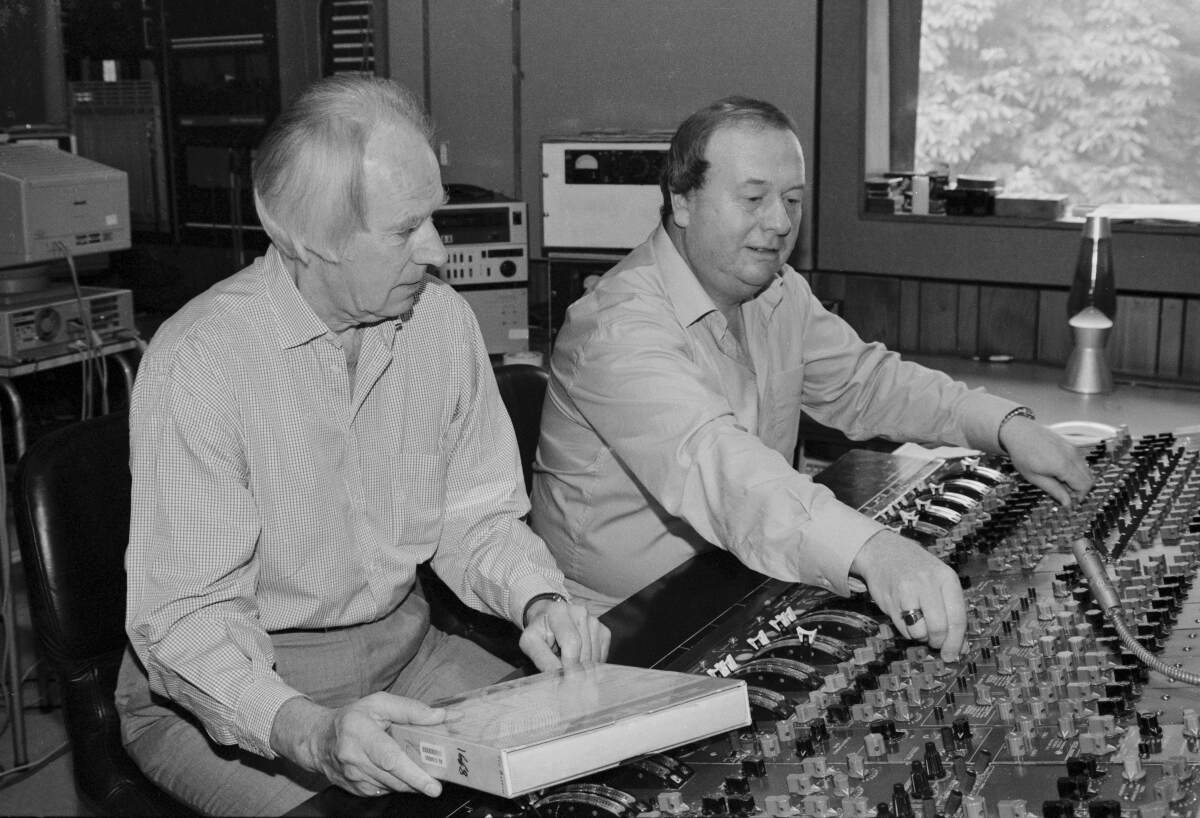
Playing side two of “Abbey Road” for a reporter last spring, Martin noted that the new mix still wasn’t finished — some sound effects, such as the cricket sounds at the opening of “Sun King,” had yet to be added back in.
But as with “Sgt. Pepper” and the White Album, “Abbey Road” gains impact, clarity and tangibility in a mix that brings the recording presumably that much closer to what the band sounded like in the studio five decades ago.
George Harrison’s finger-picked guitar opening pops out of the speakers on “Here Comes the Sun,” and the octave-hopping Moog synthesizer part that doubles the guitar arpeggios in the midsong break now sends deeper vibrations into the floorboards.
The exquisite three-part vocal harmonies from Lennon, McCartney and Harrison on “Because” — which were overlaid a second and then a third time to create the rich, nine-layer vocal mix — are that much more visceral.
“It’s all done by feel,” Martin said. “You want to go with what they intended, then you listen to everything, you think about it and you just try to get it right.”
Echoing a sentiment consistently expressed in recent years by surviving Beatles McCartney and Starr, Martin observed in listening through the “Abbey Road” tapes that regardless of what frictions may have been developing outside the studio over business matters or shifting personal dynamics, when it came to making music together, the Beatles chemistry remained unmistakable.
“The camaraderie was definitely there. You can’t sing ‘Because’ with those three-part harmonies around the same microphone without having some camaraderie,” Martin said.
Longtime “Breakfast With the Beatles” radio show host Chris Carter concurs.
“I think they had to know this was the end,” Carter said. “It would be almost foolish to end an album with a song called ‘The End’ if it wasn’t. If you were writing a script about a rock ’n’ roll band, and you wanted that band to go out with a bang, that’s what you’d do. You couldn’t write a better ending.”
More to Read
The biggest entertainment stories
Get our big stories about Hollywood, film, television, music, arts, culture and more right in your inbox as soon as they publish.
You may occasionally receive promotional content from the Los Angeles Times.
